Timothy Truman and Mike Gold discuss the classic series.
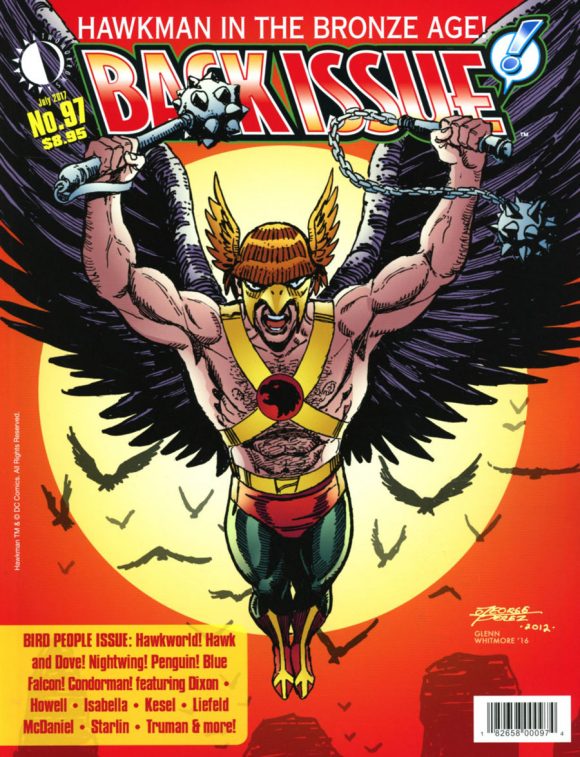
—
I don’t write about him as much as I’d like but I really dig Hawkman. I admit it’s something of a latter-day awakening, but I was really excited to see that the latest issue of Back Issue focused so much on the Winged Warrior. Issue #97 — which also features many other bird-themed heroes and villains — hit some stores this week and will be hitting more into early June. Here’s the table of contents:
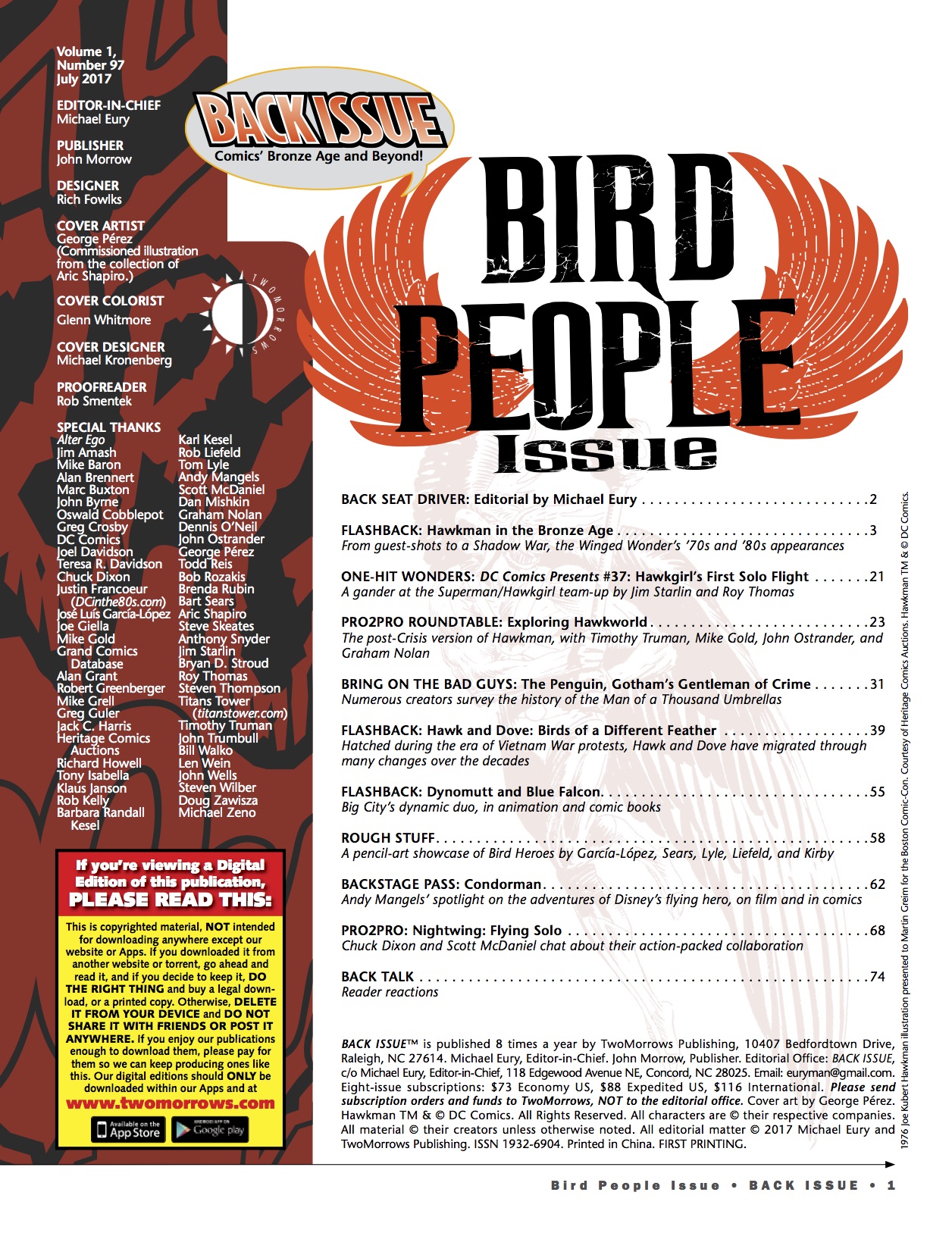
Anyway, in this month’s Back Issue excerpt here at 13th Dimension, artist-writer Timothy Truman and editor Mike Gold talk about Hawkworld, the groundbreaking 1989 miniseries that reset the world of Hawkman. The portion below deals with the mini, but you can find more on the ongoing series in the issue itself. I highly recommend picking it up.
It’s especially timely considering the recent Death of Hawkman miniseries and this summer’s looming Metal, featuring a certain element and what just might be the return of … well, I guess we’ll see…
—
By STEVEN WILBER
Hawkworld, a series that touched upon politics, religion, race, gender, sex, and more, explored the adventures of galactic police officers Katar Hol and Shayera Thal. In 1989 Hawkman and Hawkwoman were revised, then later completely retconned, after the series’ success. Attempts to mend continuity gaps created controversy among some fans. In time, however, more readers grew to love the new socially minded Hawkman and his quick-tempered partner.
These Winged Warriors were originally the reincarnated souls of an Egyptian prince and princess, later revised as visitors from the planet Thanagar. It was this later incarnation that saw the DC Universe undergo a complete overhaul with Crisis on Infinite Earths in 1985. Many of DC’s characters’ histories were radically altered, but for the most part, the Hawks remained unchanged. That was, until the end of their short-lived series in December of 1987. Following this it was decided by DC editorial that Hawkman and Hawkwoman were in need of a serious update that matched the rapidly changing and maturing medium of comic books.
Enter: Mike Gold and Timothy Truman.
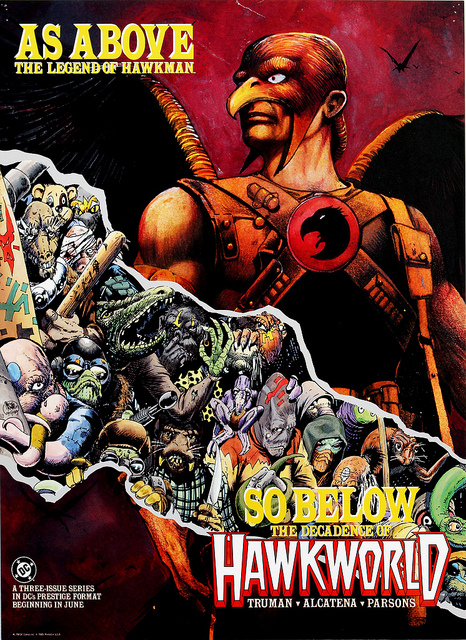
Timothy Truman: Hawkman was one of the DC titles that I’d followed when I was growing up in the 1960s—the Joe Kubert and Murphy Anderson Silver Age stuff, you know? In the early ’90s, Mike Gold was the guy who got me interested in doing the initial three-issue Prestige series. I’d worked with Mike a few years earlier at First Comics when I was drawing Grimjack.
Mike Gold: I was a huge fan [of Hawkman]. Brave and Bold #34 [Hawkman’s first Silver Age appearance, written by Gardner Fox and drawn by Joe Kubert] changed my life—of course, I was barely ten, so there wasn’t all that much to change. It was the coolest comic book I’d read and would remain that way until Fantastic Four #1 came out. I’ve been a fan of the character and an even bigger fan of Kubert ever since. I liked the idea of a married superhero team, and the visuals were spectacular.
Truman: DC had enjoyed a big success with Frank Miller’s rewiring of Batman, so of course they got all hot about revising some of their other primary characters as well. Hawkworld was one of the first follow-ups. Mike called and asked if I’d be interested. I have to admit that initially I stonewalled him a bit.
On the phone, Mike had said something to the effect of, “Wanna come over to DC and play with the big guys?” I’d been heavily involved doing creator-owned work with Eclipse and some of the other early independent companies and it felt a bit like I’d be selling out. Frankly, while Mike’s a good friend, and I’m sure he didn’t mean it that way, I took the comment as kind of a slight. I was really proud of the work I’d been doing with the indies.
So it took me awhile to warm up to the idea.
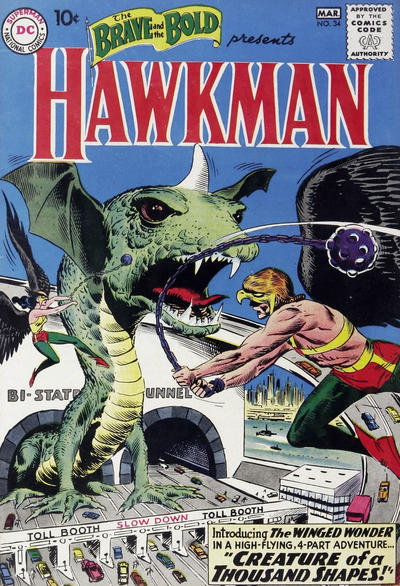
Joe Kubert
With editor Mike Gold and writer/artist Timothy Truman on board, a plan was formulated to have Hawkman and his cast fit more in line with modern trends being explored at DC Comics. But Gold and Truman would evolve their own corner of the fictional universe into something all its own.
Gold: Timothy and I have a strong and well-developed working relationship. I respect the hell out of his storytelling instincts and his out-and-out humanity, and when he told me he was interested in doing a contemporary tribute to Gardner Fox, I was right there with him all the way. It was quite a gritty story, very faithful to the concepts of all the previous Hawkman series, but told in a very contemporary manner. The “as above, so below” mentality was extremely political, and that particularly appealed to me. Timothy can bring both the grit of the undersociety and the gleam of the privileged society to the page like nobody else.
Truman: The thing that made me finally agree to do the book was the friendship I’d cultivated with Gardner Fox. I’d met Gar in the early ’80s at Gencon, while I was still doing game illustrations for TSR Hobbies/Dungeons and Dragons. We’d become pals, corresponding with each other via the mail and phone. When I got involved with indy comics companies, Gar became fascinated by the strides that comic-book people like myself had made in the way of creators’ rights. So finally he hit me with an idea he was working up, a long, sword-and-sorcery or space-opera tale along the lines of Edgar Rice Burroughs’ John Carter of Mars. I never got to see the plot that he worked up, just a few paragraphs about the basic idea.
I told him that I’d love to do it, but at the time I had too many commitments with Airboy, Scout: War Shaman, and the 4Winds books for Eclipse.
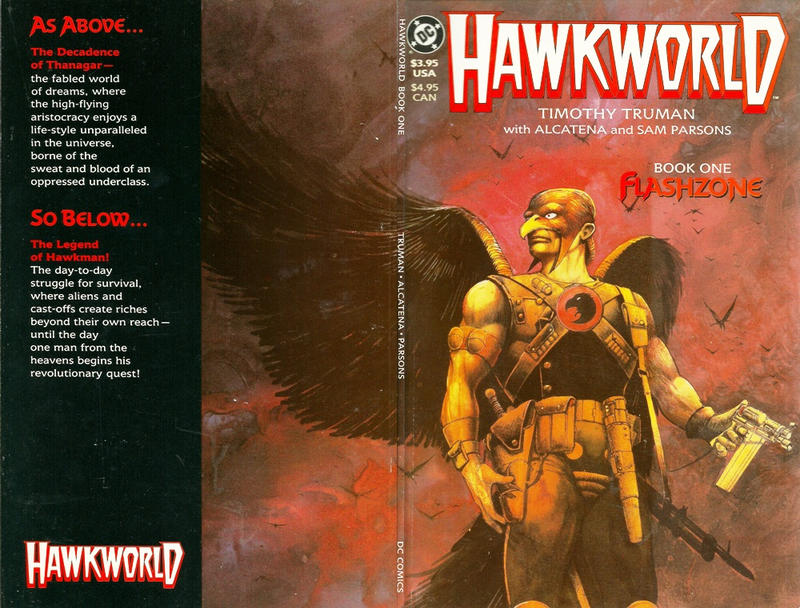
Gardner Fox had planted the seed for what would develop into a three-issue Prestige Format miniseries titled Hawkworld. Truman created a grand opera drenched deep in science fiction. A young “wingman,” Ensign Katar Hol, is introduced to readers. Despite his aristocratic upbringing, or perhaps in spite of it, Hol insists on pulling duty in the lowly Downside. Below the high-reaching towers among the clouds where the wealthy and influential prospered, refugees and criminals from all over the galaxy lived in ghettos and slums. Being the son of Paran Katar, the scientist responsible for developing Nth metal (an isotope that negates gravity), did not win favor among his fellow officers, even though Nth metal is what keeps the wingmen airborne. Hol’s admiration for Thanagar’s ancient hero, Kalmoran, with his antiquated notions of honor, also fail to impress colleagues and associates alike. It becomes evident to Hol that his commander, Byth, has far-reaching connections in Downside and is as corrupt as the politicians he abhors. In his first “flashzone,” Katar helped to rescue a group of orphans, but quickly learned few things are ever by-the-book.
Truman: I was taking Katar Hol back to his origins. It seemed logical to set the set the story on his homeworld, Thanagar. When I thought about Gar’s desire to do an old-fashioned John Carter-type space-and-swords story, I kept seeing these Roy G. Krenkel illustrations in my head—those big, amazing buildings that he used to dream up for his Burroughs stuff and the Otis Adelbert Kline Ace [paperback] covers, right? So I wanted to inject that feeling into the work and visualize this epic, utopian fantasy world. At the same time, I didn’t want to make the thing seem old-fashioned thematically.
I wanted to get a little heavier with it—an action story but with some meat on its bones. When I started re-reading the old Hawkman stories that Gar and Joe Kubert had done, the majority of the early ones were set on Thanagar. They gave the impression that Thanagar was this near-perfect Utopian society. I’ve always been a little leery of Utopian thinking.
Since Gar had established that Katar Hol was an ardent archeologist and historian, I used that as the foundation for the rest of the story. Katar is interested in the tales of Kalmoran, the ancient Thanagarian warrior hero who built their civilization. During the course of his adventure, Hawkman finds out that his big hero isn’t all that the history books make him out to be. So Hawkworld became the tale of a how Katar Hol works through his disillusionment and eventual failure, finds redemption, and re-emerges on the other side as a hero. The history and culture of Thanagar becomes a key element in getting him there.
Gold: Whenever you make a political statement, the laws of diametrics kick in and a few people will take issue. However, most people want a good, solid story, and all the elements that were used in that political context were already there, so we got very little push-back. My boss, Dick Giordano, was extremely sympathetic to our point of view and stood solidly behind the project.
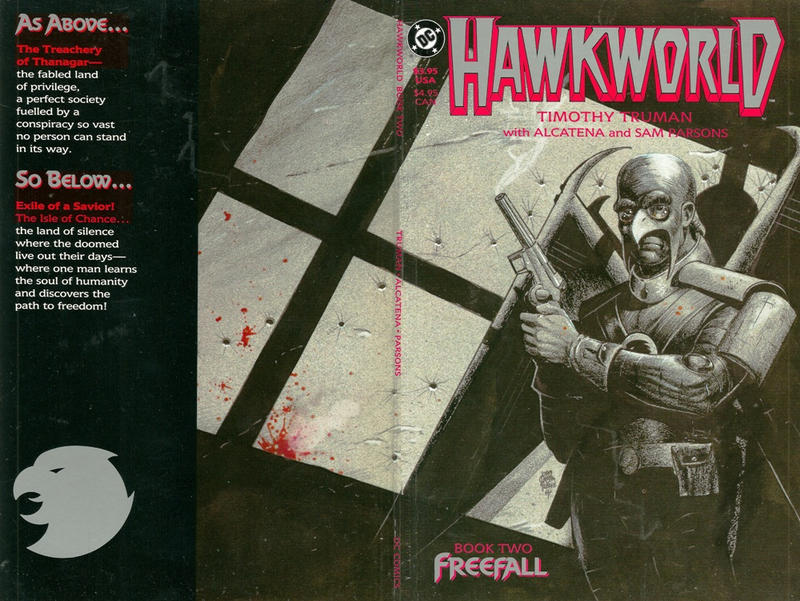
For its first issue, Hawkworld divided itself equally between the High Towers and Downside, showing the stark differences between these two societies. At the request of his father, Katar attended a party open to the elite of Thanagar.
There he (and readers) were introduced to Commissioner Andar, Chief Administrator Thal Porvis, and Porvis’ daughter, Shayera. Through conversation it’s explained that Thanagar had conquered several worlds, decimating populations and usurping resources. It’s clear that the decadence of the Towers upsets Hol despite Shayera’s urging to loosen up. But based on the treatment of “lowlies” used as servants and his time in the Downside, Katar is not comfortable with the state of affairs of his home planet. If anyone is sympathetic to Hol’s concerns, it’s his father… not that they could sway those around them.
Truman: As a history buff, I knew that civilizations only become mega-societies when they’re built on the backs of common folk. The old trickle-down economic theory never, ever works. Somehow, the labor class never seems to reap the same rewards as the guys who own the towers. So that became my starting point.
While Hol continued as a wingman, the pressures and influences around him—both from above and below—began to take hold and he soon realized he was no better than his peers. Then his world completely unraveled.
Just after leaving Katar’s arms, Shayera is killed in an explosion and her father is horribly mutilated. The wingmen take flight and pursue leads, following a false trail to the Manhawks (humanoid/bird hybrids) and arebel spy. Confronted with the traitor, Katar guns down his enemy only to realize—too late—that it was his father! Paran Katar had been secretly suppling Downsider rebels with food and medicine and was trying to negotiate peace when he was discovered. Hol had been manipulated by Byth. Framed for his father’s murder, Katar is stripped of his uniform and station and exiled to the Isle of Chance.
There on the island, suffering from shame, anger, and withdrawal from drugs, Katar kills one of the few inhabitants. His reasoning—to steal the wings the man was making—was not unlike Daedalus of Greek legend.
The fallen monk’s brother revealed the wings were always intended for Katar and his act of aggression wqs unwarranted. Hol is consumed with guilt, but R’d Nar T’so leads Katar towards enlightenment, helping the former wingman to cleanse both body and soul. Years later, after his mentor had passed and Katar is truly all alone, a ship from the city is sent to retrieve him. Hol is left in the Downside to begin a new chapter and continue on with his father’s unfinished work.
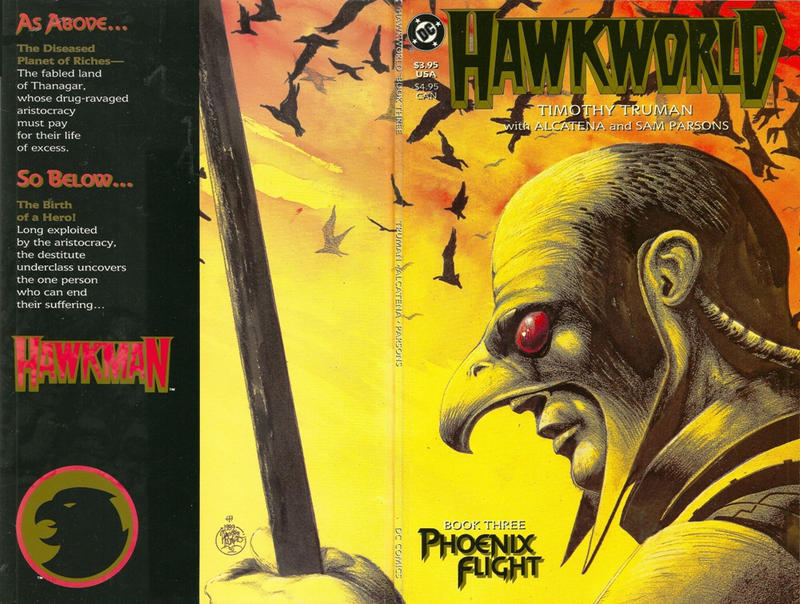
Truman: It was funny. The fans got it immediately, but it took some of the old-school reviewers awhile to catch on. Dear old Don Thompson of the Comics Buyer’s Guide gave the first issue a scathing review, I remember. He didn’t like the fact that I took Katar down a rather dark path on his way to redemption. But by the third and final issue, even Don had caught on and loved the book. You have to remember that long-format stories like Dark Knight and Hawkworld were pretty rare in those days. People were used to tidy little 20-page-story monthly comics wherein the hero was conceived one way and stayed that way issue-to-issue, for 10, 20, 30 years. However, my biggest writing influences were novels. There was one novel in particular that I’d read—The Chinese Bandit by Stephen Becker [1975]—that had made a huge impact on me. In the novel, the lead character starts out as this heartless, self-serving tough guy, but through the course of the story he experiences things that put him through a lot of changes. In the end, he’s not the same character he was at the beginning.
In Katar Hol’s absence, Byth rose to power after being given the title “Administrator of Protection.” Byth’s corruption through the Downside continued unabated, and he was now able to shape-shift, a side effect of the Krotan drug he had abused for years. Byth appeared to be unstoppable. It wasn’t until a female wingman took notice of a Downsider rebel that Byth’s empire would begin to unravel.
The young wingman, Shayera Thal, was the adopted daughter of Chief Administrator Porvis, taken in because of her resemblance to his deceased daughter. Thal discovered Katar and his relief efforts among the Downsiders.
Shayera would reveal that she had been one of the orphans “rescued” by Katar during his first assignment, and it wasn’t long before they teamed up against Byth and his forces. Following a climactic battle the villain manages to escape, but not before Shayera could accrue enough evidence to topple his empire. As a reward for their heroism, Katar was reinstated and partnered with Shayera. Their first major assignment as a duo would be to follow Byth to Earth and bring him back to Thanagar for trial.
—
For more, check out Back Issue #97, on sale now from TwoMorrows.
Vintage cover scans courtesy of the soaring Grand Comics Database.

May 27, 2017
Back Issue No. 97 is a collector’s item for Hawkfans! And thanks for the great article on Hawkworld! This series was maybe the first time I realized I was holding my breath when I finished reading it. Amazing story and art by Timothy Truman, Quique Alcatena and Sam Parsons.